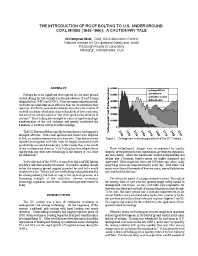Mining Publication: The Introduction of Roof Bolting to U.S. Underground Coal Mines (1948-1960): A Cautionary Tale
Original creation date: August 2002
Perhaps the most significant development in coal mine ground control during the last century was the introduction of roof bolting during the late 1940's and 1950's. From an engineering standpoint, roof bolts are inherently more effective than the wood timbers they replaced. Roof bolts promised to dramatically reduce the number of roof fall accidents, which then claimed hundreds of lives each year, and they were initially hailed as "one of the great social advances of our time." Roof bolting also emerged at a time of rapid technologic transformation of the coal industry, and greatly accelerated the transition to trackless, rubber-tired face haulage. The U.S. Bureau of Mines quickly became the new roof support's strongest advocate. Some state agencies and miners were skeptical at first, but nearly everyone was soon won over. Case histories were reported showing that roof falls could be largely eliminated while productivity increased dramatically. Little wonder that, in the words of one contemporary observer, "roof bolting has been adopted more rapidly than any other new technology in the history of coal mine mechanization." Yet by the end of the 1950's, it was clear that roof fall fatality incidence rates had actually increased. It would be another decade before the superior ground support provided by roof bolts would clearly save lives. The story of how roof bolting was implemented by the mining industry, but took so long to live up to its promise, is a fascinating example of the interaction between economics, technology, regulation, and science. It still has important lessons for today.
Authors: C Mark
Conference Paper - August 2002
NIOSHTIC2 Number: 20023136
21st International Conference on Ground Control in Mining. Morgantown, WV: West Virginia University, 2002 Aug; :150-160
See Also
- ARBS - Analysis of Roof Bolt Systems - 2.5.02
- Development and Application of the Coal Mine Roof Rating (CMRR)
- Diagnosing and Controlling Moisture-Sensitive Roof in Coal Mines
- Factors Influencing Intersection Stability in U.S. Coal Mines
- Mistakes, Misconceptions, and Key Points Regarding Secondary Roof Support Systems
- Optimizing Secondary Roof Support with the NIOSH Support Technology Optimization Program (STOP)
- Performance Characteristics for Welded Wire Screen Used for Surface Control in Underground Coal Mines
- Preventing Falls of Ground in Coal Mines With Exceptionally Low-Strength Roof: Two Case Studies
- Preventing Injuries Caused by Unrecognized Stone Mine Roof Beam Failures With a Pro-Active Roof Control Plan
- Roof and Rib Fall Incident Trends: a 10-Year Profile
- Page last reviewed: 9/21/2012
- Page last updated: 9/21/2012
- Content source: National Institute for Occupational Safety and Health, Mining Program


 ShareCompartir
ShareCompartir
